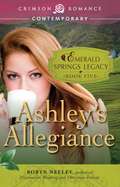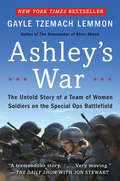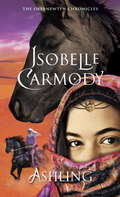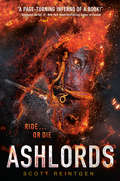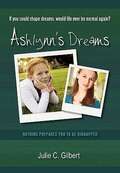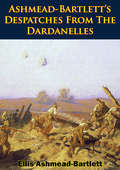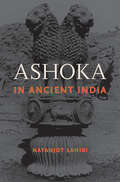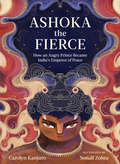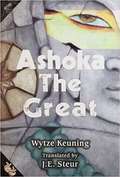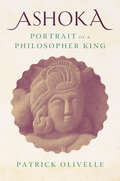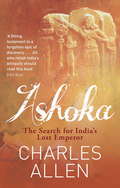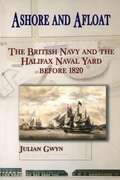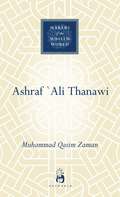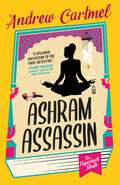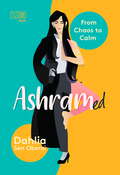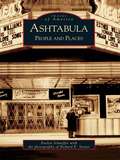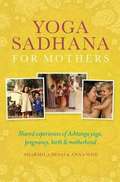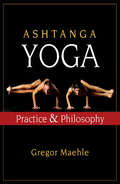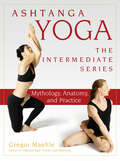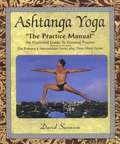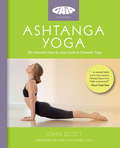- Table View
- List View
Ashley's Allegiance: Book 5 in the Emerald Springs Legacy
by Robyn NeeleyMeet Ashley, the fifth of five unforgettable characters in the Emerald Springs Legacy.Life in the small town of Emerald Springs, Washington, is anything but slow and peaceful. An old feud between former business partners Whitman and Sanders keeps competition on a high burner, fueling resentment, renewing rivalries . . . and love. Now someone is trying to bring down Emerald Tea Farm, and it’s up to both families to protect their future while still wrangling over the past.The last five months have been nothing short of exciting for the Whitmans and Sanders. Adam, Chad, and Daniel Whitman have all begun to carve out their niche in the family dynasty. Now it’s Ashley Whitman’s turn. She’s ready to step up with her marketing ideas, talent, and drive to prove she has just as much to contribute to the family tea legacy as her successful cousins.Deputy Sheriff Jacob Sanders is closing in on who is responsible for the suspicious activities plaguing Emerald Tea Farm and Split Acres. When a questionable encounter outside the local bar forces him to tag along to San Diego and play bodyguard to Ashley Whitman, any other man would jump at the chance to be in close quarters with the beautiful, blonde Whitman. Too bad they hate each other. Forced to spend time together, they discover their mutual dislike might be something else entirely. But can a Whitman and a Sanders really be happy together?Sensuality Level: Sensual
Ashley's War: The Untold Story of a Team of Women Soldiers on the Special Ops Battlefield
by Gayle Tzemach LemmonThe New York Times–bestselling account of an elite team of female soldiers is “compelling. . . . In battle as in life, these women refuse to quit” (Christian Science Monitor).In 2010, the Army created Cultural Support Teams, a secret pilot program to insert women alongside Special Operations soldiers battling in Afghanistan. Their presence had a calming effect on enemy households, but more importantly, the CSTs were able to search adult women for weapons and gather crucial intelligence. They could build relationships—woman to woman—in ways that male soldiers in an Islamic country never could.In Ashley’s War, Gayle Tzemach Lemmon uses on-the-ground reporting and a finely tuned understanding of the complexities of war to tell the story of CST-2, a unit of women hand-picked from the Army to serve in this highly specialized role. The pioneers of CST-2 proved for the first time that women might be physically and mentally tough enough to become Special Ops.The price of professional acceptance was personal loss and social isolation: the only people who really understand the women of CST-2 are each other. At the center of this story is a friendship and the shared perils of up-close combat. At the heart of the team is the tale of a beloved and effective soldier, Ashley White. “An unforgettable story of female soldiers breaking the brass ceiling. . . . This book will inspire you.” —Sheryl Sandberg, #1 International bestselling author of Lean In“A tremendous story. . . . Very moving.” —The Daily Show with Jon Stewart“Ashley’s War shares the remarkable stories of one of the first teams of women serving in the U.S. Army Special Operations Command.” —Senator John McCain
Ashling (Obernewtyn #3)
by Isobelle CarmodyAs head of Obernewtyns Farseeker guild, Elspeth Gordie must travel to the lowlands to seal an alliance between Obernewtyn and the rebel forces that oppose the totalitarian Council. Yet her dreams call to her with an altogether different purpose: Elspeth must destroy what remains of the weapons that brought unimaginable chaos, death, and mutation to her world. Leaving the relative safety of the mountains, Elspeth embarks on a journey that takes her across the sea and into the heart of the mysterious desert region of Sador.
Ashlords (Ashlords #1)
by Scott ReintgenRed Rising meets The Scorpio Races in this epic fantasy following three phoenix horse riders--skilled at alchemy--who must compete at The Races--the modern spectacle that has replaced warfare within their empire. <p><p> Every year since the Ashlords were gifted phoenix horses by their gods, they've raced them. First into battle, then on great hunts, and finally for the pure sport of seeing who rode the fastest. Centuries of blood and fire carved their competition into a more modern spectacle: The Races. <p> Over the course of a multi-day event, elite riders from clashing cultures vie to be crowned champion. But the modern version of the sport requires more than good riding. Competitors must be skilled at creating and controlling phoenix horses made of ash and alchemy, which are summoned back to life each sunrise with uniquely crafted powers to cover impossible distances and challenges before bursting into flames at sunset. But good alchemy only matters if a rider knows how to defend their phoenix horse at night. Murder is outlawed, but breaking bones and poisoning ashes? That's all legal and encouraged. In this year's Races, eleven riders will compete, but three of them have more to lose than the rest--a champion's daughter, a scholarship entrant, and a revolutionary's son. Who will attain their own dream of glory? Or will they all flame out in defeat?
Ashlynn's Dreams
by Julie GilbertJillian and her babysitter, Danielle, get kidnapped because she can shape people's dreams. Join Jillian as she learns her Gift, searches for her brother, and fights to free herself and her babysitter.
Ashmead-Bartlett’s Despatches From The Dardanelles
by Ellis Ashmead-BartlettPublished during the Great War, this book by Ellis Ashmead-Bartlett (1881-1931), a British war correspondent during the First World War, covers the preparations for the assault on Gallipoli, the naval Battle of the Dardanelles, the landings at ANZAC and Cape Helles and the battles for Krithia, Achi Baba and the heights of ANZAC from March to July 1915.Through his reporting of the Battle of Gallipoli, Ashmead-Bartlett was instrumental in the birth of the Anzac legend, which still dominates military history in Australia and New Zealand. Outspoken in his criticism of the conduct of the campaign, he was instrumental in bringing about the dismissal of the British commander-in-chief, Sir Ian Hamilton--an event that led to the evacuation of British forces from the Gallipoli peninsula.
Ashoka in Ancient India
by Nayanjot LahiriIn the third century BCE Ashoka ruled in South Asia and Afghanistan, and came to be seen as the ideal Buddhist king. Disentangling the threads of Ashoka's life from the knot of legend that surrounds it, Nayanjot Lahiri presents a vivid biography of an emperor whose legacy extends far beyond the bounds of his lifetime and dominion.
Ashoka the Fierce: How an Angry Prince Became India’s Emperor of Peace
by Carolyn KanjuroThe story of how Ashoka the Fierce became known as Ashoka the Great. As a boy, Ashoka was overlooked as a successor to his father, the emperor. He grew to become arrogant, impatient, and above all, angry. Wanting nothing more than to be king, Ashoka learned to be cunning, and when he finally managed to ascend to the throne, he was eager for war. But after a particularly brutal battle, Ashoka was heartbroken and haunted by the death and devastation he had caused. This moment marked a momentous change of heart. Upon returning home, Ashoka&’s wife encouraged him to study and practice the Buddhist teachings and to move beyond his destructive past. When Ashoka finally met a wise Buddhist monk, it transformed the way he saw the world and the role of an emperor. Ashoka spent the rest of his days tirelessly working to help his people and promoting the qualities of compassion, tolerance, and virtue.
Ashoka the Great
by Wytze KeuningAshoka The Great chronicles the life of Emperor Ashoka. The original Dutch version was a trilogy, published separately in three volumes. The trilogy was written between 1937-1947 by a Dutch scholar Wytze Keuning in Groningen in the Netherlands. These three volumes Ashoka: The Wild Prince, Book I, Ashoka: The Wise Ruler, Book II and Ashoka: The World's Great Teacher, Book III are now brought together and presented in this single volume Ashoka The Great. The book is an exhilarating, spiritually edifying and deeply moving story of one of India's greatest emperors. It recreates the life and times of the Mauryas with an authenticity that is remarkable. The book presents a plausible vision of the past balanced by a captivating story. It is said that a great book if it is to endure cannot do without profound ideas. Keuning perfectly fuses facts and thoughts, Mauryan customs and mores, life and reflection on the meaning of life as seen through the vision of Ashoka's gurus and the history of personal influences upon Ashoka that marked his rule and legacy. This and more makes it a rare and distinguished book.
Ashoka: Lion Of Maurya
by Ashok K. BankerYoung prince Ashoka accidentally overhears two men in a city tavern: a band of assassins have infiltrated Pataliputra, capitol of the great Mauryavansh empire. Their target — the entire imperial family. The prince makes it his mission to root out the assassins with the help of the Chandikas — the female military order instituted by Samrat Chandragupta Maurya. But when his own lover, a Chandika, confesses a terrible secret, he realizes that the threat lies within his own family! Meanwhile, the palace is not without its own intrigues. Queen Khorasan and her mother are playing their own game of thrones. Dowager Queen Apama is secretly working for her father, Seleucus Nicator, who still has ambitions of invading the sub-continent. King Bindusara’s harsh methods are turning the marbled floors of the imperial palace awash with blood. Will Prince Ashoka be able to save his family — and Mauryavansh — before it’s too late? India’s epic storyteller turns his masterful hand to the life of ancient India’s greatest ruler, Ashoka in a thrilling trilogy packed with non-stop action, adventure, battles and lusty no-holds-barred storytelling.
Ashoka: Portrait of a Philosopher King
by Patrick OlivelleAn illuminating biography reconstructing the life and legacy of a unique king in world history and the most famous emperor in South Asian history There are few historical figures more integral to South Asian history than Emperor Ashoka, a third-century BCE king who ruled over a larger area of the Indian subcontinent than anyone else before British colonial rule. Ashoka sought not only to rule his territory but also to give it a unity of purpose and aspiration, to unify the people of his vastly heterogeneous empire not by a cult of personality but by the cult of an idea—&“dharma&”—which served as the linchpin of a new moral order. He aspired to forge a new moral philosophy that would be internalized not only by the people of his empire but also by rulers and subjects of other countries, and would form the foundation for his theory of international relations, in which practicing dharma would bring international conflicts to an end. His fame spread far and wide both in India and in other parts of Asia, and it prompted diverse reimaginations of the king and his significance. In this deeply researched book, Patrick Olivelle draws on Ashoka&’s inscriptions and on the art and architecture he pioneered to craft a detailed picture of Ashoka as a ruler, a Buddhist, a moral philosopher, and an ecumenist who governed a vast multiethnic, multilinguistic, and multireligious empire.
Ashoka: Satrap Of Taxila
by Ashok K. BankerYoung prince Ashoka accidentally overhears two men in a city tavern: a band of assassins have infiltrated Pataliputra, capitol of the great Mauryavansh empire. Their target — the entire imperial family. The prince makes it his mission to root out the assassins with the help of the Chandikas — the female military order instituted by Samrat Chandragupta Maurya. But when his own lover, a Chandika, confesses a terrible secret, he realizes that the threat lies within his own family! Meanwhile, the palace is not without its own intrigues. Queen Khorasan and her mother are playing their own game of thrones. Dowager Queen Apama is secretly working for her father, Seleucus Nicator, who still has ambitions of invading the sub-continent. King Bindusara’s harsh methods are turning the marbled floors of the imperial palace awash with blood. Will Prince Ashoka be able to save his family — and Mauryavansh — before it’s too late? India’s epic storyteller turns his masterful hand to the life of ancient India’s greatest ruler, Ashoka in a thrilling trilogy packed with non-stop action, adventure, battles and lusty no-holds-barred storytelling.
Ashoka: The Search for India's Lost Emperor
by Charles AllenIndia's lost emperor Ashoka Maurya has a special place in history. In his quest to govern India by moral force alone he turned Buddhism from a minor sect into a world religion, and set up a new yardstick for government. But Ashoka's bold experiment ended in tragedy and he was forgotten for almost two thousand years.In this beautifully written, multi-layered journey Charles Allen describes how fragments of the Ashokan story were gradually discovered, pieced together by a variety of British Orientalists: antiquarians, archaeologists and epigraphists. In doing so, they did much to recover India's ancient history itself. The Lost Emperor tells the story of the man who was arguably the greatest ruler India has ever known.
Ashore and Afloat: The British Navy and the Halifax Naval Yard Before 1820
by Julian GwynThis book tells the early history of the Halifax Naval Yard. From the building of the yard and its expansion, to the people involved in the enterprise, to the nuts and bolts of buying the masts and paying the bills.
Ashraf `Ali Thanawi: Islam in Modern South Asia (Makers of the Muslim World)
by Muhammad Qasim ZamanAshraf Ali Thanawi (1863-1943) was one of the most prominent religious scholars in Islamic history. Author of over a thousand books on different aspects of Islam, his work sought to defend the Islamic scholarly tradition and to articulate its authority in an age of momentous religious and political change. In this authoritative biography, Muhammad Qasim Zaman offers a comprehensive and highly accessible account of Thanawi's multifaceted career and thought, whilst also providing a valuable introduction to Islam in modern South Asia.
Ashram Assassin: The Paperback Sleuth (The Paperback Sleuth #2)
by Andrew CartmelHumorous cozy-crime caper in which a feisty, amoral book dealer uses her unique skills to catch a murderer, desperate to hide the secrets kept by the yoga-obsessed staff and students of a West London ashram.When a set of rare, impossible-to-find yoga books are stolen from a West London ashram, its leaders turn to Cordelia, the paperback sleuth, to recover them – a set-up that&’s a little awkward as they&’ve previously barred her from yoga classes for selling marijuana to their students. But what begins as a hunt for missing paperbacks soon becomes a murder investigation as those involved with the ashram can&’t seem to stop dropping down dead – murdered with a whisky bottle to the head or a poisoned curry. Can Cordelia work out who the killer is and bring them to justice before they bring an end to her sleuthing for good.
Ashram Observances in Action
by M. K. GandhiGandhiji's ideas in regard to this New Education did not, of course, suddenly emerge from his brain in 1937, but were the outcome of long years of sustained thought and experience. The present book relates to this earlier formative period when he revolted from the prevailing system of education and sought in various ways to substitute it by educational practices more in harmony with his own conception of the function of education. To understand adequately the Basic Education scheme which he formulated in 1937 it is essential to go back to this earlier period where we can see it in origin and growth. The present book may, therefore, be said to be a necessary companion volume to the one on Basic Education.
Ashramed: From Chaos to Calm
by Dahlia Sen OberoiAs a new year rounds the corner, Dahlia Sen Oberoi, a hotshot lawyer whose life revolves around court appearances, client meetings and trotting around the globe, finds herself yearning for something more. With a lifelong passion for fitness, Yoga was something that she had dabbled in as an amateur enthusiast. And when she discovers a Yoga teacher's training course offered by an ashram, she forces herself to face the question: If not now, when?And so she sets off on her quest to move away from her uncompromising life as a lawyer and find some calm. Living sans her precious laptop, attending lectures on the Gita, learning and perfecting new asanas, and spending her days washing bartans and cleaning dormitories, is at first a struggle. But gradually, her self-doubt and restlessness wash away. Emotions are kept in rein, arrogance gives way to acceptance, and as Dahlia gets used to this new existence, she rediscovers herself in surprisingly new ways.At once profound and humorous, this delightfully candid account of her 30-day-long transformational sojourn will take readers on a joyous and emotionally rich journey. Ashramed is sprinkled with laughter and wisdom, and the assurance that in life, there are no timestamps, that it is always a good idea to take chances and embark on a journey of self-transformation, and most importantly, that it is never too late to do what you love.
Ashtabula: People and Places (Images of America)
by Evelyn Schaeffer Richard E. StonerPost-World War II Ashtabula was a major Great Lakes port with a thriving downtown. Local photographer Richard E. Stoner began taking photographs of the growing city in 1938, and for the next 58 years, his lens captured Ashtabula's businesses, industries, and citizens. His commercial accounts ranged from the harbor's Pinney Dock and Transport Company, to Main Avenue's locally-owned Carlisle-Allen Company department store, to Ashtabula's major war industries. Dick Stoner's earlier photographs capture the Ashtabula that once was, including the week-long Sesquicentennial Celebration of 1953. His later photos record the beginnings of fundamental change in our way of life. Also included in this volume are some pre-1930s photographs by Vinton N. Herron, whose work Stoner purchased when Herron retired. For Ashtabulans, this is a family album. For others, it is a look at a bygone time in Midwest America.
Ashtamga Yoga: Yoga in the Tradition of Sri K. Pattabhi Jois (The Definitive Primary Series Practice Manual)
by Petri RaisanenThe most physical and dynamic form of yoga, Ashtanga combines an impressive sequence of yoga poses with special breathing techniques to heat the body internally and allow safe stretching of the muscles. Ashtanga's enthusiasts point to the powerful impact of the practice on their overall health and well-being: regular practice tones and strengthens the muscles, cleanses the body of toxins, calms the mind and increases concentration.
Ashtanga Yoga
by Gregor MaehleAshtanga Yoga: Practice and Philosophy is the first book of its kind, presenting a comprehensive guide to all eight limbs of Ashtanga Vinyasa Yoga. Join author Gregor Maehle, a seasoned yogi and compassionate teacher, as he guides you through: * the history and lineage of yoga * the fundamentals of breath, bandhas (energy locks within the body), drishti (the focal point of the gaze), and vinyasa (sequential movement) * a detailed breakdown of the asanas of the Ashtanga Primary Series, following the traditional vinyasa count * a lively and authentic rendering of the complete Yoga Sutra of Patanjali, yoga's ancient sacred text * a glossary of yoga terminology In the asana section, Maehle describes each posture with clear, meticulous instructions, photographs, anatomical illustrations, and practical tips. Information on the mythological background and yogic context of specific postures brings further insight to the practice. In the philosophy section, Maehle illuminates the Yoga Sutra using the major ancient commentaries as well as his own insights. This volume makes the entire path of Ashtanga Yoga accessible to modern practitioners. Both practical guide and spiritual treatise, Ashtanga Yoga is an excellent introduction to the eight limbs of yoga and an invaluable resource for any yoga teacher or practitioner.
Ashtanga Yoga - The Intermediate Series: Mythology, Anatomy, and Practice
by Gregor MaehleIn this much-anticipated follow-up to his first book, Ashtanga Yoga: Practice and Philosophy, Gregor Maehle offers a detailed and multifaceted guide to Ashtanga Yoga’s Intermediate Series. An expert yogi and teacher, Maehle will guide you to your next level with an unprecedented depth of anatomical explanation and unparalleled attention to the practice’s philosophical and mythological heritage. You will learn: • The background and applications of each of the three forms of yoga: Karma, Bhakti, and Jnana • How to use Indian myth and cosmology to deepen your practice • The importance of the Sanskrit language to the yogic tradition • The mythology behind the names of the Intermediate Series postures • The functions and limitations of body parts integral to the Intermediate Series, including the spine, the sacroiliac joint, the shoulder joint, and the hip joint • How to reap the full benefits of practicing the Intermediate Series Maehle meticulously explores all twenty-seven postures of the Intermediate Series through photos, anatomical line drawings, and practical, informative sidebars. He also discusses the philosophical and spiritual background of Ashtanga Yoga and places the practice within the context of Indian cultural history. With passionate erudition, Maehle will prepare you to reap physical, spiritual, and mental fulfillment from your evolving practice.
Ashtanga Yoga Primer
by Baba Hari DassAshtanga Yoga, also known as Raja Yoga, is the scientific method of enlightenment propounded by the sage Patanjali in his Yoga Sutras. Baba Hari Dass has been active in training students and teachers of yoga in the United States and Canada. Through his compassionate example, young and old alike are learning the gentle art of living in peace.
Ashtanga Yoga The Practice Manual: A Simplified Guide For Daily Practice
by David SwensonWhether new to Ashtanga or an experienced student or teacher, readers will find this book to be invaluable. It contains over 650 photos and multiple variations for every asana in the primary and intermediate series plus three short forms. Its spiral binding assures easy use while practicing and the hard cover increases durability.
Ashtanga Yoga: The Definitive Step-by-step Guide To Dynamic Yoga
by John Scott Shri K.Pattabhi JoisJohn Scott's Ashtanga Yoga is a step-by-step illustrated guide that takes you through the balanced exercise routines and breathing techniques of this dynamic form. Carefully structured, this course starts with a simple sequence for beginners which, once mastered, provides the foundation for moving on to the next level.- Purify your body with dynamic movement and precise postures- Develop physical and mental strength, increased stamina and greater flexibility- Includes a foreword by Shri K Pattabhi Jois, founder of Ashtanga Yoga- This new edition has been fully revised and updated This essential guide is the perfect introduction to yoga or the ideal gift for those who want to take their yoga practice to the next level.Author John Scott studied with yogi Shri K Pattabhi Jois at the Ashtanga Yoga Research Institute in India, where he qualified to teach Ashtanga Yoga around the world. He has instructed many people in Ashtanga Yoga, including high-profile celebrities Madonna and Sting. John now spends much of his time teaching international workshops and undertaking teacher trainings.
